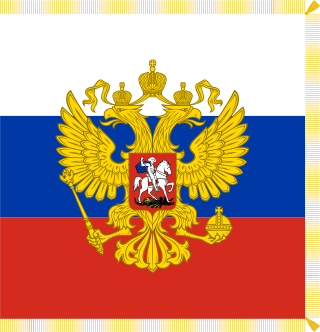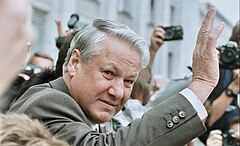
The penultimate USSR-era flag was adopted by the Russian Soviet Federative Socialist Republic (RSFSR) in 1954 and used until 1991. The flag of the Russian SFSR was a defacement of the flag of the USSR. The constitution stipulated:
The state flag of the Russian Soviet Federative Socialist Republic (SFSR) presents itself as a red, rectangular sheet with a light-blue stripe at the pole extending all the width [read height] which constitutes one eighth length of the flag.

The president of Russia, officially the president of the Russian Federation, is the executive head of state of Russia. The president is the chair of the Federal State Council and the supreme commander-in-chief of the Russian Armed Forces. It is the highest office in Russia.
The Presidium of the Supreme Soviet of the Russian Soviet Federative Socialist Republic was the collective head of state of the Russian SFSR and the permanent body of the Supreme Soviet of the Russian SFSR that was accountable to the Supreme Soviet of the Russian SFSR in its activity and, within the nominal limits prescribed by the Constitution of the Russian SFSR, performed functions of the highest state power in the Russian SFSR between 1938 and 1990. It was elected by the Supreme Soviet of the Russian Soviet Federative Socialist Republic to perform the Supreme Soviet's activities when it was not in session, which, in practice, was most of the year.

Ivan Stepanovich Silayev was a Soviet and Russian politician. He served as Prime Minister of the Soviet Union through the offices of chairman of the Committee on the Operational Management of the Soviet economy and chairman of the Inter-republican Economic Committee. Responsible for overseeing the economy of the Soviet Union during the late Gorbachev era, he was the last head of government of the Soviet Union, succeeding Valentin Pavlov.

When the Soviet Union existed, different governments had ruled the northern Caucasus regions of Chechnya and Ingushetia. Within the Mountain Autonomous Socialist Soviet Republic, later annexed into the Russian Socialist Federative Soviet Republic, they were known as the Chechen Autonomous Oblast and the Ingush Autonomous Oblast, which were unified on January 15, 1934, to form the Checheno-Ingush Autonomous Oblast. It was elevated to an autonomous republic as the Checheno-Ingush Autonomous Soviet Socialist Republic from 1936 to 1944 and again from 1957 to 1993. Its capital was Grozny.

Presidential elections were held in the Russian Soviet Federative Socialist Republic (RSFSR) on 12 June 1991. This was the first Russian presidential election in the country's history. The election was held roughly three months after Russians voted in favor of establishing a presidency and holding direct elections in a referendum held in March that year. The result was a victory for Boris Yeltsin, who received 58.6% of the vote.

The government of Russia is the federal executive body of state power of the Russian Federation. The members of the government are the prime minister, the deputy prime ministers, and the federal ministers. It has its legal basis in the Constitution of the Russian Federation and the federal constitutional law "On the Government of the Russian Federation". The Apparatus of the Government of Russia is a governmental body which administrates the activities of the government.

The Congress of People's Deputies of the Russian SFSR and since 1992 Congress of People's Deputies of the Russian Federation was the supreme government institution in the Russian SFSR and in the Russian Federation from 16 May 1990 to 21 September 1993. Elected on 4 March 1990 for a period of five years, it was dissolved by presidential decree during the Russian constitutional crisis of 1993 and ended de facto when the Russian White House was attacked on 4 October 1993. The Congress played an important role in some of the most important events in the history of Russia during this period, such as the declaration of state sovereignty of Russia within the USSR, the rise of Boris Yeltsin, and economic reforms.

A referendum on creating the post of President of Russia was held in the Russian Soviet Federative Socialist Republic on 17 March 1991. The referendum was held alongside a referendum of the preservation of USSR. Prior to the referendum, the Russian head of state was the Chairman of the Supreme Soviet of the Russian SFSR, elected by the Congress of People's Deputies of the Russian SFSR. With 71% of voters approving the proposal, the post of President of the Russian SFSR was introduced, and two months later Boris Yeltsin was elected as the first president.

The vice president of the Russian Federation was a political office in Russia which existed from 1991 to 1993. The only occupant of this office was Alexander Rutskoy. The vice president was the first in the Russian presidential line of succession, becoming the new president of Russia upon the death, resignation, or removal of the president. Additionally, the vice president executed individual assignments on a commission of the president and acted for the president in his absence or in case when it would be impossible for the president to attend to his duties.

The Declaration of State Sovereignty of the Russian SFSR was a political act of the Russian Soviet Federative Socialist Republic, then part of the Soviet Union, which marked the beginning of constitutional reform in Russia. The Declaration was adopted by the First Congress of People's Deputies of the Russian SFSR on 12 June 1990. It proclaimed the sovereignty of the Russian SFSR and the intention to establish a democratic constitutional state within a liberalized Soviet Union. The declaration also states the following:

The Communist Party of the Russian Soviet Federative Socialist Republic, was a communist political party in the Russian SFSR. The Communist Party of the Russian SFSR was founded in 1990. At this point, the Communist Party of the Russian SFSR being the republican branch of the Communist Party of the Soviet Union, organized around 58% of the total Communist Party membership. Politically, it became a centre for communist opponents of Gorbachev's leadership.

The Russian Soviet Federative Socialist Republic, previously known as the Russian Soviet Republic and the Russian Socialist Federative Soviet Republic, and unofficially as Soviet Russia, was an independent federal socialist state from 1917 to 1922, and afterwards the largest and most populous constituent republic of the Soviet Union (USSR) from 1922 to 1991, until becoming a sovereign part of the Soviet Union with priority of Russian laws over Union-level legislation in 1990 and 1991, the last two years of the existence of the USSR. The Russian SFSR was composed of sixteen smaller constituent units of autonomous republics, five autonomous oblasts, ten autonomous okrugs, six krais and forty oblasts. Russians formed the largest ethnic group. The capital of the Russian SFSR and the USSR as a whole was Moscow and the other major urban centers included Leningrad, Stalingrad, Novosibirsk, Sverdlovsk, Gorky and Kuybyshev. It was the first socialist state in history.

The Ministry of Finance of the Russian Soviet Federative Socialist Republic, known prior to 1946 as the People's Commissariat for Finance, or shortened to Narkomfin, was part of the government of the Russian Soviet Federative Socialist Republic from 1918 until the fall of the USSR in 1991. It was subordinate to the Ministry of Finance of the USSR.

The Russian presidential inauguration is a ceremony to mark the start of a term of the president of Russia. The president's term is six years. In the case of extraordinary election, the inauguration is conducted thirty days after the announcement of the official election results by the Central Election Commission of Russia. Since Vladimir Putin's first inauguration in 2000, the ceremony took place in the Grand Kremlin Palace of the Moscow Kremlin. The inauguration ceremony of the Russian president has traditionally been accompanied by the festive prayer service of the Patriarch of Moscow and all Rus', which dates back to 1498, when the first wedding took place for the reign of Prince Dmitry Ivanovich, the grandson of Ivan III.

The presidency of Boris Yeltsin began with his first inauguration on 10 July 1991, and ended on 31 December 1999 when he announced his resignation. A referendum held on 17 March 1991 approved the creation of the post of president of Russia; Yeltsin was elected Russia's first president in a presidential election held on 12 June 1991.

Second cabinet of Ivan Silayev was the last composition of the Council of Ministers of the Russian Soviet Federative Socialist Republic, working from July to November 1991. Most of its members kept their positions from the Ivan Silayev's First Cabinet which was dissolved after Boris Yeltsin officially took office as president on 10 July 1991.

The first cabinet of Ivan Silayev was the composition of the Council of Ministers of the Russian Soviet Federative Socialist Republic in office from July 1990 to July 1991.
General elections were held in the Chechen Republic on 27 October 1991 to elect the president and parliament. The presidential election resulted in a victory for Dzokhar Dudayev.
















